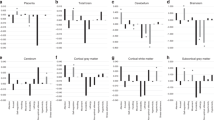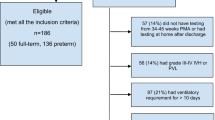Abstract
Aim:
Evaluate prospectively the neurobehavior of preterm infants (PT).
Study design:
Cohort of PT (gestational age(GA) <32weeks), evaluated biweekly from 32 to 48 weeks post-menstrual age (PMA) by NICU Network Neurobehavioral Scale (NNNS). Scores were compared by repeated Measures ANOVA. Scores of PT were compared to those of full-term infants, matched for gender by ANOVA.
Results:
39 PT (mean ± SD: GA 29.2 ± 2.0 weeks; birthweight 1100 ± 331g) were studied. As PMA progressed, PT showed increasing scores in habituation, attention, arousal, regulation, maneuvers for orientation, quality of movements and hypertonicity, and decreasing scores in excitability, lethargy, non-optimal reflexes, asymmetry, hypotonicity, and signs of stress/withdrawal. At 40 weeks PMA, PT were similar to term neonates assessed in the first days of life, except for less habituation, regulation capacity and excitability, and more hypotonia.
Conclusion:
At 40 weeks PMA, PT reached the performance of full-term neonates evaluated in the first days of life in most neurobehavior domains.

Similar content being viewed by others
References
Center for disease Control and Prevention, 2015. [homepageon the Internet]. Access 17 March 2017. Available from: https://www.cdc.gov/nchs/pressroom/sosmap/preterm_births/preterm.htm
Blencowe H, Lee AC, Counsens S, Bahalim A, Narwal R, Zhong N, et al. Preterm birth-associated neurodevelopmental impairment estimates at regional and global levels for 2010. Pediatr Res. 2013;74(Suppl 1):17–34.
Hintz SR, Kendrick DE, Vohr BR, Poole K, Higgins RD. The National Institute of Child Health and Human Development Neonatal Research Network. Changes in neurodevelopmental outcomes at 18 to 22 months’ corrected age among infants of less than 25 weeks’ gestational age born in 1993-1999. Pediatrics. 2005;115:1645–51.
Woodward LJ, Anderson PJ, Austin NC, Howard K, Inder TE. Neonatal MRI to predict neurodevelopmental outcomes in preterm infants. N Engl J Med. 2006;355:685–94.
Lester BM, Tronick EZ. History and description of the neonatal intensive care unit network neurobehavioral scale. Pediatrics. 2004;113:634–40.
Tronick E, Lester BM. Grandchild of the NBAS: the NICU network neurobehavioral scale (NNNS): a review of the research using the NNNS. J Child Adolesc Psychiatr Nurs. 2013;26:193–203.
Eeles AL, Olsen JE, Walsh JM, McInnes EK, Molesworth CM, Cheong JL, et al. Reliability of neurobehavioral assessments from birth to term equivalent age in preterm and term born infants. Phys Occup Ther Pediatr. 2017;37:108–19.
Tronick EZ, Olson K, Rosenberg R, Bohne L, Lu J, Lester BM. Normative neurobehavioral performance of healthy infants on the Neonatal Intensive Care Unit Network Neurobehavioral Scale. Pediatrics. 2004;113:676–8.
de Moraes Barros MC, Guinsburg R, Mitsuhiro S, Chalem E, Laranjeira RR. Neurobehavioral profile of healthy full-term newborn infants of adolescent mothers. Early Hum Dev. 2008;84:281–7.
Fink N, Tronick E, Olson K, Lester B. Healthy newborns’ neurobehavior: norms and relations to medical and demographic factors. J Pediatr. 2012;161:1073–9.
Spittle AJ, Walsh JM, Olsen JE, McInnes E, Eeles AL, Brown NC, et al. Neurobehaviour and neurological development in the firts month after birth for infants born between 32-42 weeks’ gestation. Ealy Hum Dev. 2016;96:7–14.
Brown NC, Doyle LW, Bear MJ, Inder TE. Alterations in neurobehavior at term reflect differing perinatal exposures in very preterm infants. Pediatrics. 2006;118:2461–71.
Pineda RG, Tjoeng TH, Vavasseur C, Kidikoro H, Neil JJ, Inder TE. Patterns of altered neurobehavior in preterm infants within the neonatal intensive care unit. J Pediatr. 2013;162:470–6.
Stephens BE, Liu J, Lester B, Lagasse L, Shankaran S, Bada H, et al. Neurobehavioral assessment predicts motor outcome in preterm infants. J Pediatr. 2010;156:366–71.
El-Dib M, Massaro AN, Glass P, Aly H. Neurobehavioral assessment as a predictor neurodevelopmental outcome in preterm infants. J Perinatol. 2012;32:299–303.
Sucharew H, Khoury JC, Xu Y, Succop P, Yolton K. NICU Network Neurobehavioral Scale profiles predict developmental outcomes in a low-risk sample. Paediatr Perinat Epidemiol. 2012;26:344–52.
Spittle AJ, Walsh JM, Potter C, Mcinnes E, Olsen JE, Lee KJ, et al. Neurobehavior at term-equivalent age and neurodevelopment outcomes at 2 years in infants born moderate-to-late preterm. Dev Med Child Neurol. 2017;59:207–15.
Papile LA, Burstein J, Burstein R, Koffler H. Incidence and evolution of subependymal and intraventricular hemorrhage: a study of infant with birth weights less than 1500g. J Pediatr. 1978;92:529–34.
Inder TE, Wells SJ, Mogridge NB, Spencer C, Volpe JJ. Defining the nature of the cerebral abnormalities in the premature infant: a qualitative magnetic resonance imaging study. J Pediatr. 2003;143:171–9.
Lester BM, Tronick EZ. The Neonatal Intensive Care Unit Network Neurobehavioral Scale procedures. Pediatrics. 2004;113:641–67.
Brazelton TB, Nugent JK. Neonatal Behavioral Assessment Scale. 3rd ed. London: Cambridge University Press; 1995. p. 150.
Boukydis CFZ, Bigsby R, Lester BM. Clinical use of the Neonatal Intensive Care Unit Network Neurobehavioral Scale. Pediatrics. 2004;113:679–89.
Barros MCM, Guinsburg R, Mitsuhiro SS, Chalem E, Laranjeira RR. Neurobehavior of late preterm infants of adolescent mothers. Neonatology. 2011;99:133–9.
ABEP. Critério Brasil 2015 e atualização da distribuição de classes para 2016. Associação Brasileira de Empresas de Pesquisa 2016;1–6. [homepage on the internet]. Access on 2019, Apr 1. Available from: http://www.abep.org/criterio-brasil.
Pickler RH, McGrath JM, Reyna BA, McCain N, Lewis M, Cone S. et al. A model of neurodevelopmental risk and protection for preterm infants. J Pediatr Neonatal Nurs. 2010;24:356–65.
Als H, Lester BM, Tronick EC, Brazelton TB. Towards a research instrument for the assessment of preterm infants’ behavior (APIB). In: Fitzgerald HE, Lester BM, Yogman MW. Theory and research in behavioral pediatrics. New York: Plenun Press; 1982. pp. 85–132.
Sweeney JK, Blackburn S. Neonatal physiological and behavioral stress during neurologic assessment. J Perinat Neonatal Nurs. 2013;27:242–52.
Amiel-Tison C. Neurologic evaluation of the maturity of newborn infants. Arch Dis Child. 1968;43:89–93.
Zernicke RF, Schneider K. Biomechanics and developmental neuromotor control. Child Dev. 1993;64:982–1004.
Liu WF, Laudert S, Perkins B, MacMillan EY, Martin S, Grave S. The development of potentially better practices to support the neurodevelopment of infants in the NICU. J Perinatol. 2007;27:548–74.
Colombo J, Mitchell DW. Infant visual habituation. Neurobiol Learn Mem. 2009;92:225–34.
Leslie ATFS, Akers KG, Martinez-Canabal A, Mello LEA, Covolan L, Guinsburg R. Neonatal inflammatory pain increases hippocampal neurogenesis in rat pups. Neurosci Lett. 2011;501:78–82.
Leijon I. Assessment of behavior on the Brazelton scale in healthy preterm infants from 32 conceptional weeks until full-term age. Early Hum Dev. 1982;7:109–18.
Castillo MU, Barros MCM, Guinsburg R. Habituation responses to external stimuli: is the habituation of preterm infants at a post-conceptual age of 40 weeks equal to that of term infants? Arch Dis Child Fetal Neonatal Ed. 2014;99:F402–7.
Olsen IE, Groveman AS, Lawson ML, Clark RH, Zemel S. New intrauterine growth curves based on United States. Data Pediatrics. 2010;125:214–24.
Funding
Foundation for Research Support of the State of São Paulo (Fundação de Amparo à Pesquisa do Estado de São Paulo - Fapesp) - Grant No 2013/05647-2
Author information
Authors and Affiliations
Corresponding author
Ethics declarations
Conflict of interest
The authors declare that they have no conflict of interest.
Additional information
Publisher’s note: Springer Nature remains neutral with regard to jurisdictional claims in published maps and institutional affiliations.
Rights and permissions
About this article
Cite this article
de Souza Perrella, V.V., Marina Carvalho de Moraes, B., Sañudo, A. et al. Neurobehavior of preterm infants from 32 to 48 weeks post-menstrual age. J Perinatol 39, 800–807 (2019). https://doi.org/10.1038/s41372-019-0376-z
Received:
Revised:
Accepted:
Published:
Issue Date:
DOI: https://doi.org/10.1038/s41372-019-0376-z
- Springer Nature America, Inc.
This article is cited by
-
Neurobehavior in very preterm infants with low medical risk and full-term infants
Journal of Perinatology (2022)
-
Impaired in vivo feto-placental development is associated with neonatal neurobehavioral outcomes
Pediatric Research (2022)
-
Randomized clinical trial investigating the effect of consistent, developmentally-appropriate, and evidence-based multisensory exposures in the NICU
Journal of Perinatology (2021)
-
Preterm infant feeding performance at term equivalent age differs from that of full-term infants
Journal of Perinatology (2020)




